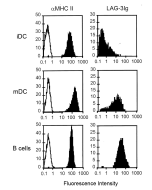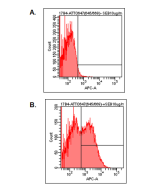Cookie Policy: This site uses cookies to improve your experience. You can find out more about our use of cookies in our Privacy Policy. By continuing to browse this site you agree to our use of cookies.
AdipoGen Life Sciences
anti-LAG-3 (human), mAb (17B4) (ATTO 488)

Human PBMC were stimulated (B) or not (A) with 1μg/ml of superantigen SEB. After 2 days, PBMC were stained with 10μg/ml (1μg/0.5x106 cells) of anti-LAG-3 (human), mAb (17B4) (ATTO 488) (Prod. No. AG-20B-0012TD) and analyzed by flow cytometry.
| Product Details | |
|---|---|
| Synonyms | Lymphocyte Activation Gene-3; FDC Protein; CD223 |
| Product Type | Monoclonal Antibody |
| Properties | |
| Clone | 17B4 |
| Isotype | Mouse IgG1κ |
| Source/Host | Purified from concentrated hybridoma tissue culture supernatant. |
| Immunogen/Antigen | Synthetic peptide corresponding to 30 aa in the N-terminus of human LAG-3. |
| Label/Conjugates | ATTO 488 |
| Application |
Flow Cytometry: (1:100) |
| Crossreactivity | Human |
| Specificity |
Recognizes human LAG-3. |
| Purity | ≥95% (SDS-PAGE) |
| Purity Detail | Protein G-affinity purified. |
| Concentration | 1mg/ml |
| Formulation | Liquid. In PBS containing 0.02% sodium azide. |
| Isotype Negative Control | |
| Other Product Data |
New ATTO-fluorescent antibodies show increased photostability, outstanding brightness and intense signals. ATTO dyes are thermally stable, resistant to environmental changes and show no significant isomerization. |
| Shipping and Handling | |
| Shipping | BLUE ICE |
| Short Term Storage | +4°C |
| Long Term Storage | +4°C |
| Handling Advice |
Do not freeze. Protect from light. |
| Use/Stability |
Keep conjugated formats at +4°C. Stable for at least 1 year after receipt when stored at +4°C. |
| Documents | |
| Protocols |
 Download PDF Download PDF |
| MSDS |
 Download PDF Download PDF |
| Product Specification Sheet | |
| Datasheet |
 Download PDF Download PDF |
Lymphocyte activation gene 3 (LAG-3; CD223) plays an important role in negatively regulating T cell proliferation, function and homeostasis. It is required for maximal natural and induced regulatory T cell (Treg) function. LAG-3 is closely related to the T cell co-receptor CD4 and binds to MHC class II molecules but with a significantly higher affinity than CD4.
- Characterization of the lymphocyte activation gene 3-encoded protein. A new ligand for human leukocyte antigen class II antigens: E. Baixeras, et al.; J. Exp. Med.176, 327 (1992)
- Cellular expression and tissue distribution of the human LAG-3-encoded protein, an MHC class II ligand: B. Huard, et al.; Immunogenetics 39, 213 (1994)
- Characterization of the major histocompatibility complex class II binding site on LAG-3 protein: B. Huard, et al.; PNAS 94, 5744 (1997)
- CD3/TCR complex-associated lymphocyte activation gene-3 molecules inhibit CD3/TCR signaling: S. Hannier, et al.; J. Immunol. 161, 4058 (1998)
- T Lymphocytes infiltrating various tumour types express the MHC class II ligand lymphocyte activation gene-3 (LAG-3): role of LAG-3/MHC class II interactions in cell-cell contacts: C.E. Demeure, et al.; Eur. J. Cancer 37, 1709 (2001)
- Immunological mechanisms elicited at the tumour site by lymphocyte activation gene-3 (LAG-3) versus IL-12: sharing a common Th1 anti-tumour immune pathway: E.D. Carlo, et al.; J. Pathol. 205, 82 (2005)
- The negative regulatory function of the lymphocyte-activation gene-3 co-receptor (CD223) on human T cells: L. Macon-Lemaitre and F. Triebel; Immunology 115,170 (2005)
- A soluble lymphocyte activation gene-3 (sLAG-3) protein as a prognostic factor in human breast cancer expressing estrogen or progesterone receptors: F. Triebel, et al.; Cancer Lett. 235, 147 (2006)
- Human dendritic cells acquire a semimature phenotype and lymph node homing potential through interaction with CD4+CD25+ regulatory T cells: J. Bayry, et al.; J. Immunol. 178, 4184 (2007)
- Human lymphocyte activation gene-3 molecules expressed by activated T cells deliver costimulation signal for dendritic cell activation: C. Casati, et al.; J. Immunol. 180, 3782 (2008)








